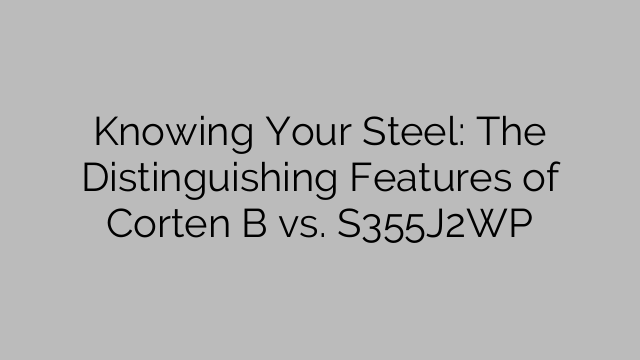Knowing Your Steel: The Distinguishing Features of Corten B vs. S355J2WP
When it comes to construction materials, steel is the go-to choice for its strength, durability, and versatility. However, not all steels are created equal. Different types of steel have distinct characteristics that make them suitable for specific applications. In this article, we will focus on Corten B and S355J2WP steels, two popular choices known for their unique properties.
Corten B and S355J2WP are weathering steels, also known as corrosion-resistant or atmospheric corrosion-resistant steels. These types of steels are designed to form a protective rust-like coating on their surfaces when exposed to the elements, thus eliminating the need for paint and reducing maintenance costs.
Corten B, also known as ASTM A588 or ASTM A242 Type 2, is a high-strength, low-alloy structural steel with excellent atmospheric corrosion resistance. It is primarily used in outdoor applications due to its ability to withstand prolonged exposure to harsh weather conditions. Corten B is commonly used in architectural structures, sculptures, and bridges, where its unique rusty appearance adds an appealing aesthetic.
One of the key distinguishing features of Corten B is its higher copper content compared to traditional carbon steels. Copper acts as a catalyst for the formation of the protective rust layer, enhancing the steel’s resistance to corrosion. Additionally, Corten B contains other alloying elements such as chromium, nickel, and phosphorus, which further contribute to its corrosion resistance.
On the other hand, S355J2WP, also known as EN 10025-5 Grade S355J2WP, is a structural steel with improved atmospheric corrosion resistance. Similar to Corten B, it forms a protective rust layer on its surface when exposed to the elements. S355J2WP is commonly used in construction and outdoor applications where strength and durability are required. It is often seen in bridges, facades, and railway wagons.
Compared to Corten B, S355J2WP has a lower copper content, making it less resistant to corrosion. However, S355J2WP compensates for this with a higher phosphorus content, which enhances its weathering properties. The addition of phosphorus allows the steel to form a tighter protective layer, providing better resistance against atmospheric corrosion.
When deciding between Corten B and S355J2WP, it is essential to consider the specific requirements of your project. While both steels offer excellent corrosion resistance, Corten B’s higher copper content may make it more suitable for applications that demand maximum durability in harsh environments. On the other hand, if cost efficiency is a priority, S355J2WP’s lower copper content and improved phosphorus content may make it a more cost-effective option.
It is important to note that both Corten B and S355J2WP require regular maintenance to ensure their long-term performance. While the protective rust layer reduces the need for painting, it is advisable to periodically inspect and clean the surface to remove any debris or contaminants that may hinder the steel’s natural weathering process.
In conclusion, understanding the distinguishing features of different types of steel is crucial when selecting the right material for your construction project. Corten B and S355J2WP are two weathering steels renowned for their corrosion resistance and unique appearance. By considering the specific requirements of your application, you can make an informed choice between Corten B and S355J2WP, ensuring optimal performance and longevity.

